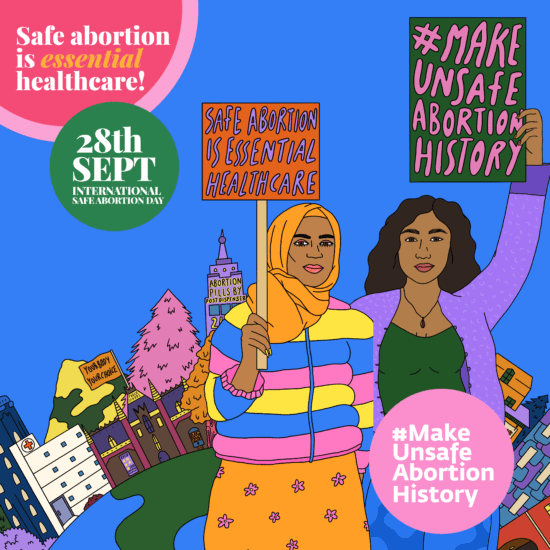Why Digital Rights are Crucial to #MakeUnsafeAbortionHistory
The 28th of September marks International Safe Abortion Day, with this year’s theme being #MakeUnsafeAbortionHistory. After a devastating year of reproductive rights regression in the U.S. and the impact of Covid-19 on accessing abortion services worldwide, it has become starkly evident just how critical it is to have access to reliable information about abortion and abortion services online. When thinking about how to make unsafe abortion history with the context of the previous year in mind, it became clear that one way of doing this is by guaranteeing easy access to reliable information on abortion care and abortion services online.
Women on Web are a non-profit organisation who have been providing support and information on safe abortion and contraception online for the past 16 years. Women on Web provide medical abortion pills to people who want an abortion, following an online consultation and review by medical professionals. The Women on Web website is also an extremely reliable resource for information and shared experiences on abortion. However, this essential source of information is censored in several countries around the world including Brazil, Saudi Arabia, Turkey[1] and last year Spain shockingly joined this list when it also censored the website during the first wave of the Covid-19 pandemic[2]. The censoring of such reproductive health websites not only denies people’s right to access information but also people’s right to informed choice regarding their health and also the right to choose. In other words, digital rights are unequivocally intertwined with reproductive rights.
All individuals have the right to access information and counselling about their health and rights. This information should be freely accessible, evidence-based and unbiased, and is critical in order to allow people to make decisions on their sexual and reproductive health, including whether they want an abortion or not, with complete and informed consent.[3]
Being full-swing in the digital age, many of us now rely heavily on the internet for information, with this especially being the case for individuals in countries where access to abortion services is limited or not permissible. The right to “to seek, receive and impart information” is enshrined in the Universal Declaration of Human Rights under Article 19[4] and is tied in tightly with the concept of digital rights, with one aspect of digital rights being the protection of people’s right to access, use, create and publish digital media.
The right to information on sexual and reproductive health and services has been voiced on many stages and in front of many commissions. It is widely acknowledged as a human right that is imperative to realising good health and the ability to exercise autonomy. The withholding of information about abortion not only violates Article 19 of the Declaration of Human Rights but also significantly harms the people who are in need of information on abortion, especially people from marginalised groups and those who experience domestic abuse.
The example of Women on Web being censored by different governments around the globe is just one example of how digital rights and access to reproductive health information are being denied, with the shadow banning of pro-choice accounts on social media platforms also being a major site for concern[5].
The need for digital innovation to ensure access to safe abortion information
While there are growing barriers to accessing information online, the safe abortion movement is persistent and luckily for us, is also full of innovators who are thinking of different ways to collect, compile and share reproductive health information. The Covd-19 pandemic also added an intensified need for innovation and access to reliable information about abortion and abortion services online, to which safe abortion advocates globally responded to. One example of this includes the Covid-19 Safe Abortion Response Map by the Preventing Unsafe Abortions partner group, formed in 2020 in response to the outbreak of Covid-19. Their interactive Safe Abortion Response Map highlights how six international organisations adapted their safe abortion and post-abortion care (PAC) programmes in the Covid-19 context, and captures stories of resilience, digital innovation, and persistent advocacy to maintain access to safe abortion during the pandemic. The map is open to everyone, with anyone being able to submit their own innovation and information to the map, creating a collaborative digital resource open to all.
Conclusion
In order to make unsafe abortion history, people must have access to reliable information about safe abortion online. We must continue to fight online censorship, and hold governments and social media platforms accountable to ensure that every person can have their reproductive needs met. We must continue to support the organisations who are dedicated to providing knowledge on abortion and abortion services and be innovative in the ongoing fight to prevent unsafe abortions in our ever-changing online and offline landscapes.
By Nicole Moran, Share-Net Netherlands Project Officer.
References
[1] https://ooni.org/post/2019-blocking-abortion-rights-websites-women-on-waves-web/
[2] https://www.womenonweb.org/en/page/20230/spain-censors-information-about-abortion-amid-covid-19-lockdown.
[3] https://www.ohchr.org/documents/publications/nhrihandbook.pdf
[4] https://www.un.org/en/about-us/universal-declaration-of-human-rights
[5] https://www.refinery29.com/en-gb/2021/06/10500889/abortion-pro-choice-censoring-tiktok
